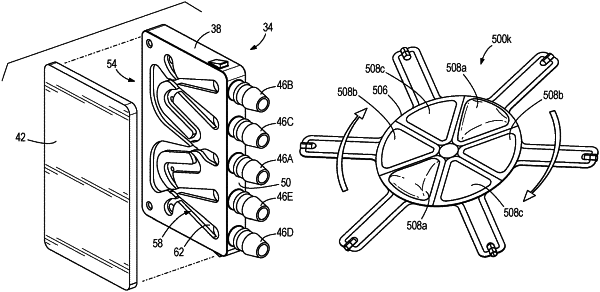| CPC A61H 9/0078 (2013.01) [B60N 2/914 (2018.02); B60N 2/976 (2018.02); A61H 2201/0149 (2013.01); A61H 2201/1238 (2013.01); A61H 2201/1409 (2013.01); A61H 2201/1642 (2013.01); A61H 2201/5002 (2013.01); A61H 2201/5056 (2013.01); A61H 2205/062 (2013.01); A61H 2205/081 (2013.01)] | 20 Claims |

|
1. A pneumatic massage system comprising:
a source of pressurized air;
a fluidic switching module in communication with the source of pressurized air;
a first bladder in communication with the fluidic switching module;
a second bladder in communication with the fluidic switching module; and
a third bladder in communication with the fluidic switching module,
wherein the fluidic switching module includes
a first subsystem having a first air splitter in fluid communication with the source of pressurized air and having a first outlet and a second outlet, wherein the first air splitter is configured to deflect an airflow toward the first outlet in response to unequal air pressure fields created between the first and second outlets by a first stationary airflow biasing feature formed in the first air splitter,
a second subsystem having a second air splitter downstream from and in fluid communication with the first outlet to receive the airflow from the first air splitter, wherein the second air splitter includes a third outlet in fluid communication with the first bladder and a fourth outlet in fluid communication with the second bladder, and wherein the second air splitter is configured to deflect the airflow toward the third outlet in response to unequal air pressure fields created by a second stationary airflow biasing feature formed in the second air splitter, and
a third subsystem in fluid communication with the first air splitter through the second outlet to receive the airflow from the first air splitter, the third subsystem including a fifth outlet in fluid communication with the third bladder;
wherein when the first bladder reaches a first threshold air pressure sufficient to create a first pressure feedback, the second subsystem is configured to switch and deflect the airflow from the third outlet toward the fourth outlet to inflate the second bladder and deflate the first bladder,
wherein when the second bladder reaches a second threshold air pressure sufficient to create a second pressure feedback, the first subsystem is configured to switch and deflect the airflow from the first outlet toward the second outlet to deflate the second bladder and inflate the third bladder via the third subsystem,
wherein when the third bladder reaches a third threshold air pressure sufficient to create a third pressure feedback, the first subsystem system is configured to switch and deflect the airflow from the second outlet back toward the first outlet to inflate the first bladder and deflate the third bladder.
|